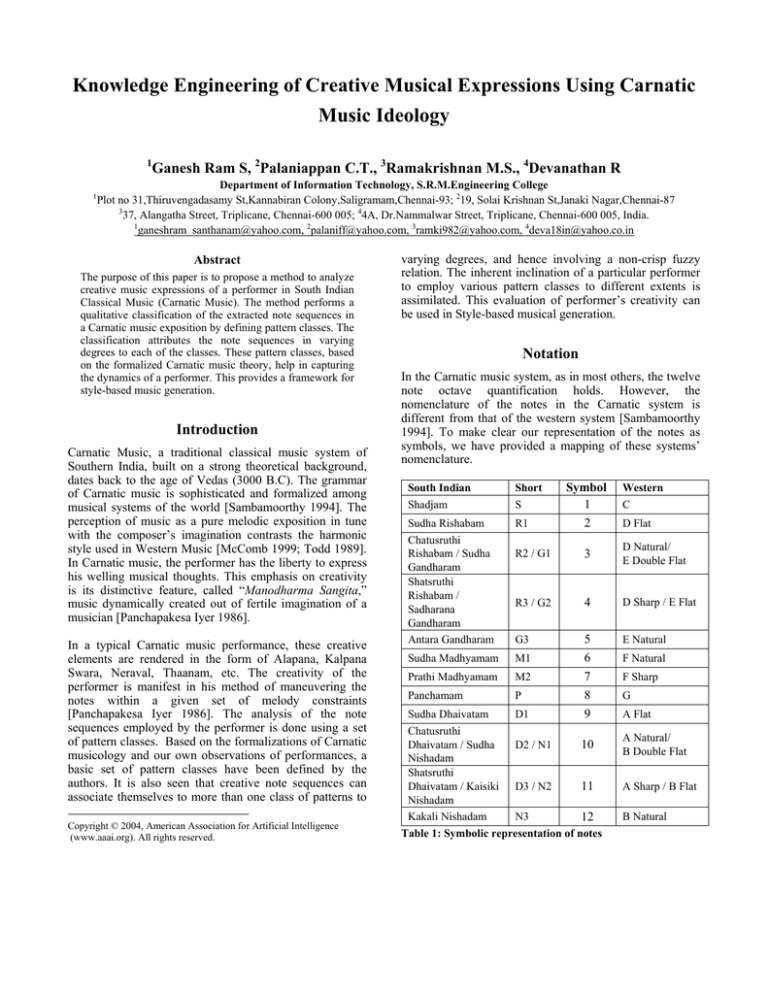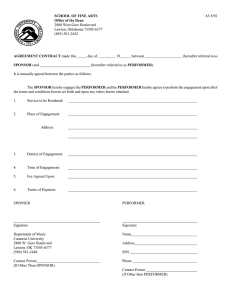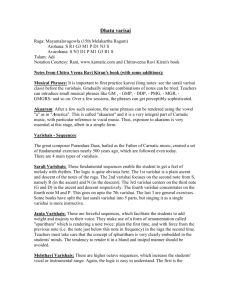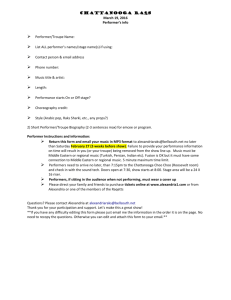
Knowledge Engineering of Creative Musical Expressions Using Carnatic
Music Ideology
1
Ganesh Ram S, 2Palaniappan C.T., 3Ramakrishnan M.S., 4Devanathan R
Department of Information Technology, S.R.M.Engineering College
Plot no 31,Thiruvengadasamy St,Kannabiran Colony,Saligramam,Chennai-93; 219, Solai Krishnan St,Janaki Nagar,Chennai-87
3
37, Alangatha Street, Triplicane, Chennai-600 005; 44A, Dr.Nammalwar Street, Triplicane, Chennai-600 005, India.
1
ganeshram_santhanam@yahoo.com, 2palaniff@yahoo.com, 3ramki982@yahoo.com, 4deva18in@yahoo.co.in
1
Abstract
The purpose of this paper is to propose a method to analyze
creative music expressions of a performer in South Indian
Classical Music (Carnatic Music). The method performs a
qualitative classification of the extracted note sequences in
a Carnatic music exposition by defining pattern classes. The
classification attributes the note sequences in varying
degrees to each of the classes. These pattern classes, based
on the formalized Carnatic music theory, help in capturing
the dynamics of a performer. This provides a framework for
style-based music generation.
Introduction
Carnatic Music, a traditional classical music system of
Southern India, built on a strong theoretical background,
dates back to the age of Vedas (3000 B.C). The grammar
of Carnatic music is sophisticated and formalized among
musical systems of the world [Sambamoorthy 1994]. The
perception of music as a pure melodic exposition in tune
with the composer’s imagination contrasts the harmonic
style used in Western Music [McComb 1999; Todd 1989].
In Carnatic music, the performer has the liberty to express
his welling musical thoughts. This emphasis on creativity
is its distinctive feature, called “Manodharma Sangita,”
music dynamically created out of fertile imagination of a
musician [Panchapakesa Iyer 1986].
In a typical Carnatic music performance, these creative
elements are rendered in the form of Alapana, Kalpana
Swara, Neraval, Thaanam, etc. The creativity of the
performer is manifest in his method of maneuvering the
notes within a given set of melody constraints
[Panchapakesa Iyer 1986]. The analysis of the note
sequences employed by the performer is done using a set
of pattern classes. Based on the formalizations of Carnatic
musicology and our own observations of performances, a
basic set of pattern classes have been defined by the
authors. It is also seen that creative note sequences can
associate themselves to more than one class of patterns to
Copyright © 2004, American Association for Artificial Intelligence
(www.aaai.org). All rights reserved.
varying degrees, and hence involving a non-crisp fuzzy
relation. The inherent inclination of a particular performer
to employ various pattern classes to different extents is
assimilated. This evaluation of performer’s creativity can
be used in Style-based musical generation.
Notation
In the Carnatic music system, as in most others, the twelve
note octave quantification holds. However, the
nomenclature of the notes in the Carnatic system is
different from that of the western system [Sambamoorthy
1994]. To make clear our representation of the notes as
symbols, we have provided a mapping of these systems’
nomenclature.
South Indian
Shadjam
Short
S
Sudha Rishabam
Chatusruthi
Rishabam / Sudha
Gandharam
Shatsruthi
Rishabam /
Sadharana
Gandharam
Antara Gandharam
R1
Sudha Madhyamam
M1
Prathi Madhyamam
M2
Panchamam
P
Symbol
1
2
Western
C
D Flat
R2 / G1
3
D Natural/
E Double Flat
R3 / G2
4
D Sharp / E Flat
G3
5
6
7
8
9
E Natural
Sudha Dhaivatam
D1
Chatusruthi
Dhaivatam / Sudha
D2 / N1
10
Nishadam
Shatsruthi
Dhaivatam / Kaisiki D3 / N2
11
Nishadam
Kakali Nishadam
N3
12
Table 1: Symbolic representation of notes
F Natural
F Sharp
G
A Flat
A Natural/
B Double Flat
A Sharp / B Flat
B Natural
Pattern Classes
Enumeration of pattern classes for our proposed
system
A pattern is defined as a set of ordered elements. Our
system needs to classify sequences in a more generalized
method, rather than as specific set of discrete sequences.
For example, one could not gain much by defining the
pattern {1, 2, 3}, as occurrences of {3, 4, 5} would not
count as the same pattern. A more general representation
encompassing both the above patterns would be {x, x+1,
x+2}, where x is any arbitrary note.
In line with our requirements for a more general
classification of sequences, we consider Pattern Classes. A
Pattern Class can be expressed as a class which contains
pattern of the form {sequence <belongs to> value set}. By
value set we mean the allowable note sequences in a
particular Pattern Class.
It turns out that note sequences employed by the performer
in a particular performance belong to a set of pattern
classes. Thus, rather than a one – to – one association of a
sequence to a pattern class, it is appropriate to associate a
sequence in terms of ‘degree’ of membership to each of
the classes. The membership of a sequence to a pattern
class can be interpreted as a degree of certainty to which a
sequence belongs to a particular pattern class.
In the following, we have enumerated a set of basic pattern
classes based on the Carnatic Music theory [Panchapakesa
Iyer 1986].
No.
1
2
3
Name
Swaravali (Sarali)
Jandai
Dhattu
Pattern Class
1234…8(asc) 8765 …1(desc)
111111…11
1323 2434 3545 … 6878
8676 …… 5343 4232 3121
4
Udhvahita
1232 2343 3454 … 6787
8767 … 5434 4323 3212
5
Hladhamana
1432 2543 3654 ... 5876
8567 …… 6345 5234 4123
6
Uthkadhita
12 543 23 654 … 45 876
87 456 76 345 … 54 123
7
Bindhu
1112 2223 3334 … 7778
8887 7776 6665 … 2221
8
Trivarna
12 333 23 444 … 67 888
87 666 … 43 222 32 111
9
Hasitha
1 22 333 4444 … 88888888
88888888 … 4444 333 22 1
Table 2: Example Pattern Classes defined based on Carnatic
musicology
Although this enumeration represents most common
pattern classes that have been formalized, more classes can
be evolved. Enrichment of the existing library of classes
can be through more detailed classes / subclasses or class
extensions as dictated by the performers’ creativity. These
extensions and dynamic new classes widen the scope of
evaluation of a performer.
System Architecture
The analysis of note sequences focuses on the creative
elements in the contexts of a Carnatic music concert. A
note sequence is taken as an input token to the system. The
system measures its degree of attribution to each of the
classes. The domain of the degrees of attribution is the
rational number set between 0 and 1.
When a sequence has no attribution to any of the available
pattern classes the scope of the existing library of pattern
classes needs to be widened. A non-attributed sequence,
which occurs frequently, is generalized to form a new
pattern class.
The processes and the data interactions involved are
elucidated in the system architecture. Figure 1 gives a view
of this architecture.
System Block Diagram
Music Sample
Transcriber
Sequence
Fuzzy Classifier
Pattern
Measures
Sequence
User pattern
Enrichment
New classes
Evaluate
Pattern Counts
Measure Degree of
attribution of
sample to each
pattern class
Knowledge
Figure 1: Block diagram of the system
Pattern
Classes
3.
Basic Process Units involved in this System
Transcriber: The transcriber reads the musical sample in
a wave format and converts them to note format saved in a
file that can be processed further. The transcriber outputs
the note sequences.
Pattern Classes: The pattern classes that we have
modeled form a library. The knowledge of a performer is
to be quantified into sets, each set containing attributions
of samples to the pattern classes. Each of these sets
contains a template descriptor for an ordered symbol
sequence. The cardinality of this set is the number of
samples taken for this performer.
Fuzzy Classifier: The classifier is a process that compares
the note sequence with the patterns in the class library. The
note sequences are parsed to determine the presence of
each of the pattern classes. The note sequences might
resemble or satisfy the conditions of more than one class.
We define an algorithmic module called membership
function. All possible class matches in these note
sequences are to be enumerated. A count of the matches to
a particular class provides an individual quantitative
measure. It is then processed further to obtain qualitative
information.
Performer-based Pattern Enrichment: The classes we
have modeled in this system cover most patterns. A
performer might still exceed these limits and use some of
his distinctive patterns. These can be incorporated for
further enrichment of the system. The pattern enrichment
process determines the distinct new patterns and updates
the class library.
Update on Fuzzy Sets: Once the count of each pattern in a
sample is known, we need to determine their degrees of
belonging to each of these classes. The total number of
patterns used dictates the effect of each of these patterns in
this sample. We measure the degree of belonging to a class
by a simple proportion. We calculate the ratio of the
number of times a pattern occurs out of the total number of
times all patterns occur. The degrees of each of these
classes are appended to the fuzzy sets of the performer.
This gives the knowledge output, which can be put into
use effectively for various applications.
Functional Specification of the System
The system aims to capture the essence of the creative
music expressions in a qualitative representation. The
sequence of steps involved in this process is enumerated
below.
1.
2.
Read the music sample in wave format
Convert these music samples into note format
The notes are saved as text, enumerating the
sequence of notes.
4. The note sequence is parsed for fuzzy
classification and for enrichment of pattern
classes.
5. The sequences are parsed to determine the count
and degree of belonging to different patterns. The
sequence might contain more than one pattern and
the patterns might be superimposed.
6. Then the system evaluates the number of times a
pattern class is present in the sample.
7. An array of counts of the number of times the
note patterns recur in the sample is determined.
8. The proportion of each pattern in the sample is
determined by
P(X) = N(X) / N(S)
Where N(S) is the number of pattern units
recurring in the entire note sequence. N(X) is the
number of times the pattern for Class X has been
repeated. P(X) gives the proportion of the class X’s
occurrence in the entire sample. This value falls
between 0 and 1.
9. The degrees P(X) for each of the classes X in the
class library is appended to the set for the Class
X.
10. The knowledge represented in this form can be
used to reproduce or generate patterns based on
the weight of these classes in the Performers’
samples.
Delineating further complex classes enrich the system
further. We have the classes divided based upon more
specific pattern usage. Matrices can replace the sets that
we have used here if the length of the creative patterns can
be considered as contributing to the creativity of these
patterns. Thus each column of these matrices would now
indicate the length of the notes employed in that pattern.
Illustration
In this section, we illustrate the entire process of the
system as outlined above.
The heart of the system, the fuzzy classifier, parses the
entire sequence. Whether a pattern occurs or not is
determined by a descriptor or membership function. This is
a rule, which imposes certain conditions for association.
For example, for Jandai, the definition would be {x, x}.
On detection of a pattern (Eg: {1,1}, it increments the hit
count on that Jandai class. Further, both 11 and 444444
come under the {x, x} pattern class because, for each
paired subsequence, both notes are the same.
Moreover, it is also important to note that a single
subsequence could belong to more than one pattern class.
Consider the following sequence.
337241654276587555554444333221
Close observation of the notes reveals that in the first part
of the sequence, there is a Hladhamana pattern class.
33724 1654 2765 87 555554444333221
Although the occurrence does not match the exact value
stored class library, it is a modified version of the pattern.
Thus, in place of
{x, x+4, x+3, x+2}, {x, x+5, x+4, x+3}
can be used. In fact, it would be more general if we
represented the membership function or condition as
{x, x+n, x+n-1, x+n-2, …}
It is also observable that the last part of the given sequence
resembles both “Hasita,” and “Swaravali(desc)” classes
(however to varying degrees). In addition, the “Hasita” is
superimposed on the descending “Swaravali”. This also
justifies our use of fuzziness.
In order to determine the measure of association to a
pattern class, we again use a “degree of occurrence” based
approach to the problem. In the above example, the first
occurrence of 33 does not imply to a great extent that the
performer employs Jandai (duplications) more frequently.
These random notes would only contribute as noise. On
parsing of the entire sequence, the hit of 33 as Jandai
would have been eclipsed by other multiple hits on other
patterns.
In this example, it is significant that the system does
emphasize more on the occurrence of Hasita because of its
fullness of occurrence. When compared with the previous
1654 2765
Hladhamana sequence, the Hasita sequence of
555554444333221
has been employed to a fuller extent. This means that out
of the full set of
888888887777777666666555554444333221
only a subset of this sequence is employed:
55555444433321.
Therefore, the degree of association of this subsequence to
“Hasita” would be larger than that of 1654 2765 to
“Hladhamana.”
Future Work
We found that the inherent usage of patterns by the
performer while rendering Kalpana Swara is attributed to
his creativity. Hence by knowledge acquisition of patterns
specific to a performer, the computer could aptly enact his
style.
Music experts are often skeptical about music, which is
autonomously composed by computers. We have proposed
a system that captures the dynamics of the performance
based on Carnatic musicology. The knowledge acquisition
of our system will have a direct impact on the music
composition process with specific style (style based music
generation). Style in the context of a musical performance
is an implicit aspect ascribed to a performer that cannot be
consciously manipulated; however possesses quantifiable
and distinctive features.
The knowledge assimilated through this system has
applications in the fields of authorship identification,
stylometry and learning.
References
Krishnaswamy, A., 2003. Application of Pitch
Tracking To South Indian Classical Music. In the
Proceedings of the International Conference on Acoustics,
Apeech and Signal Processing, Hong Kong, China: IEEE
Inc.
Panchapakesan, A.S., eds. 1986. Karnataka Sangitha
Sashtram. Chennai: Ponolli Offset Press.
Todd, P. M. 1989. A connectionist approach to
algorithmic composition. Computer Music Journal 13: 4-4.
Sambamurthy, P. eds. 1994. South Indian Music
Volume 4. The Indian Music Publishing House, Chennai,
India.
Duda, R.O., P.E. Hart, and D.G. Stork, Pattern
Classification. Second ed. 2001: John Wiley and Sons.
Ramakrishnan M.S., Devanathan R, Palaniappan C.T.,
and Ganesh Ram S. 2003. A New Approach to Machine
Cognition of Music using Carnatic Music Ideology. In the
proceedings of the Eleventh International Conference on
Advanced Computing and Communications, 39,
Coimbatore,
India:
Advanced
Computing
and
Communications Society Inc.





